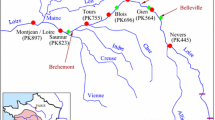Analysis of the existing formulas for the bed load allows identifying two important parameters of the bed load transport: the Froude number and the depth-particle size ratio. This article is devoted to the study of the relationship between these parameters. The study is based on the database of the State Hydrological Institute. The relationship between these parameters with the relationship determination coefficient R2 = 0.93 has been obtained. Based on the four formulas for the bed load transport and the formula for the dune velocity, the hypothesis of the interchangeability of these parameters in calculating the bed load transport has been confirmed. For wide hydraulic conditions, a formula for the mean size of bed sediments, which, under certain hydraulic conditions, are in motion as the bed load, has been obtained (average calculation error is 73%).
Similar content being viewed by others
References
Z. D. Kopaliani and O. A. Petrovskaya, “Database “Measurement data of the hydraulic characteristics of the bed load transport in large, small and medium lowland rivers” Database state registration certificate No. 2017620992),” in: Ofits. Byull. “Progr. ÉVM. Bazy Dannykh. Topol. Integr. Skhem”, No. 9 (2017).
Z. D. Kopaliani and O. A. Petrovskaya, “Database “Measurement data of the hydraulic characteristics of the bed load transport in hydraulic models of mountain rivers and flume experiments” (Database state registration certificate No. 2017620878),” in: Ofits. Byull. “Progr. ÉVM. Bazy Dannykh. Topol. Integr. Skhem”, No. 8 (2017).
Z. D. Kopaliani and O. A. Petrovskaya, “Database “Measurement data of the hydraulic characteristics of structureless bed load transport in laboratory experiments in hydraulic flumes” (Database state registration certificate No. 2017620958),” in: Ofits. Byull. “Progr. ÉVM. Bazy Dannykh. Topol. Integr. Skhem”, No. 9 (2017).
O. A. Petrovskaya, Optimization of Methods for Calculating the Bed Load Transport Taking into Account the Hydraulic Parameters of Rivers. Doctoral Thesis [in Russian], FGBU GGI, St. Petersburg (2018).
V. V. Belikov, N. M. Borisova, T. A. Fedorova, et al., “On the effect of the Froude number and hydromorphometric parameters on sediment transport in rivers,” Water Resour., 46(1), S20 – S28 (2019).
VSN163–83. Accounting for Deformations of River Channels and Reservoir Banks in the Zone of Underwater Crossings of Main Pipelines (Oil and Gas Pipelines) [in Russian], Gidrometeoizdat, Leningrad (1985).
STO GU GGI 08.29–2009. Accounting for the River Bed Evolution in the Sections of Underwater Crossings of Pipelines across Rivers [in Russian], Nestor-Istoriya, St. Petersburg (2009).
STO FGBU GGI 52.08.31–2012. Extraction of Non-Metallic Construction Materials in Water Flows. Accounting for the River Bed Evolution and Recommendations for the Design and Operation of Channel Open Pits [in Russian], Globus, St. Petersburg (2012).
V. V. Romanovskii and N. M. Kapitonov, “Methods and errors in measuring the transported bed load by the parameters of the dunes,” Tr. GGI, No. 283, 93 – 108 (1982).
G. I. Shamov, “Formulas for determining the limiting bed load velocity and transport,” Tr. GGI, No. 36(90), 3 – 17 (1952).
Archive of the Department of River Bed Processes of the State Hydrological Institute [in Russian], GGI, St. Petersburg.
V. N. Lazarev and F. M. Chernyshov, “Refinement of the calculation of the transported bed load for coarse-grained soils,” Tr. NIIVT, No. 88, 43 – 53 (1974).
V. F. Talmaza, “On the issue of the transporting capacity of rivers in the mountain-foothill zone,” Izv. AN Kirg. SSR, 5(3), 27 – 51 (1963).
K. V. Grishanin, Dynamics of Channel Flows [in Russian], Gidrometeoizdat, Leningrad (1969).
A. V. Karaushev, Theory and Calculation Methods of River Bed Loads [in Russian], Gidrometeoizdat, Leningrad (1977).
R. S. Chalov, Channels Science: Theory, Geography, Practice. Vol. 1. Channel Processes: Factors, Mechanisms, Forms of Manifestation and Conditions for the Formation of River Channels [in Russian], Izd. LKI, Moscow (2008).
Author information
Authors and Affiliations
Corresponding author
Additional information
Translated from Gidrotekhnicheskoe Stroitel’svo, No. 12, December, 2021, pp. 47 – 52. DOI: https://doi.org/10.34831/EP.2021.91.15.010
Rights and permissions
Springer Nature or its licensor (e.g. a society or other partner) holds exclusive rights to this article under a publishing agreement with the author(s) or other rightsholder(s); author self-archiving of the accepted manuscript version of this article is solely governed by the terms of such publishing agreement and applicable law.
About this article
Cite this article
Petrovskaya, O.A. On the Relationship Between the Main Parameters of Bed Load Transport. Power Technol Eng 56, 74–79 (2022). https://doi.org/10.1007/s10749-023-01474-3
Published:
Issue Date:
DOI: https://doi.org/10.1007/s10749-023-01474-3




